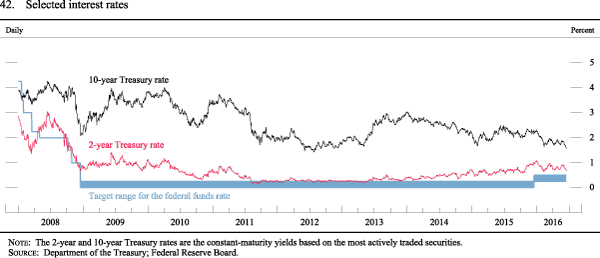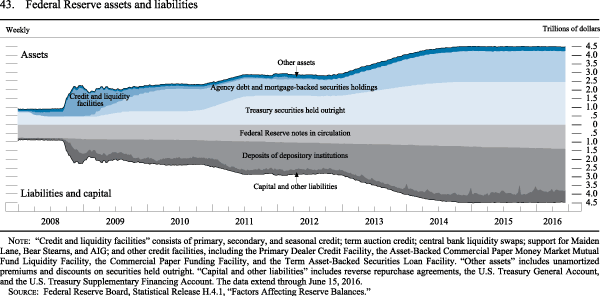- June 21, 2016: Summary
- Part 1
- Part 2
- Part 3
- Abbreviations
- Printable Version (2.74 MB PDF)

Part 2: Monetary Policy
Monetary Policy Report submitted to the Congress on June 21, 2016, pursuant to section 2B of the Federal Reserve ActOver the first half of the year, monetary policy remained accommodative to support further improvement in labor market conditions and a return to 2 percent inflation. In particular, the Federal Open Market Committee (FOMC) maintained the target range for the federal funds rate at 1/4 to 1/2 percent. This unchanged policy stance was supported, among other factors, by the FOMC's assessments in the first months of the year that global economic and financial developments posed risks to the economic outlook, and in June that recent information indicated that the pace of improvement in the labor market had slowed. In addition, the Committee's policy stance reflected its expectation that inflation would remain low in the near term. Looking ahead, the FOMC expects that economic conditions will warrant only gradual increases in the federal funds rate. In determining future adjustments to the federal funds rate, the Committee will take into account a wide range of information, including measures of labor market conditions, indicators of inflation pressures and inflation expectations, and readings on financial and international developments.
The FOMC maintained the federal funds rate target range at 1/4 to 1/2 percent in the first half of the year...
After raising the target range for the federal funds rate last December to between 1/4 and 1/2 percent, the Committee has maintained that range over the first half of the year (figure 42). This unchanged policy stance was supported initially by the Committee's assessment that global economic and financial developments posed risks to the economic outlook, as expressed in its March 2016 statement, and by its judgment in April that growth in domestic economic activity appeared to have slowed. 5 In June, the Committee noted that recent information indicated that the pace of improvement in the labor market had slowed, while growth in domestic economic activity appeared to have picked up in the spring. 6 The decision to maintain the target range for the federal funds rate also reflected the Committee's expectation that inflation would stay low in the near term, partly because of earlier declines in energy prices and in the prices of non-energy imports, as well as recently elevated uncertainty about the possible consequences of the U.K. referendum on European Union membership for the U.S. economic outlook.
Over the first half of 2016, the Committee remained particularly attentive to risks to the U.S. economic outlook posed by global economic and financial developments. The Committee noted earlier in the year that it was closely monitoring such developments and assessing their implications for the labor market and inflation and for the balance of risks to the outlook. The Committee subsequently indicated that these concerns had attenuated, but that it would continue to closely monitor inflation indicators and global economic and financial developments.
...indicated that the stance of monetary policy was likely to remain accommodative...
The Committee continued to expect that the federal funds rate was likely to remain, for some time, below levels that were expected to prevail in the longer run, and that with gradual adjustments in the stance of monetary policy, economic activity would expand at a moderate pace and labor market indicators would continue to strengthen. The Committee also continued to expect inflation to remain low in the near term but to rise to 2 percent over the medium term as the transitory effects of past declines in energy and import prices dissipate and the labor market strengthens further.
Consistent with this outlook, in the most recent Summary of Economic Projections, which was compiled at the time of the June FOMC meeting, FOMC participants projected that the appropriate level of the federal funds rate would be below its longer-run level through 2018.
...and stressed that future changes in the target range for the federal funds rate will depend on the economic outlook as informed by incoming data
The FOMC continued to emphasize that, in determining the timing and size of future adjustments to the target range for the federal funds rate, the Committee would assess realized and expected economic conditions, as informed by incoming data, relative to its objectives of maximum employment and 2 percent inflation. This assessment would take into account a wide range of information, including measures of labor market conditions, indicators of inflation pressures and inflation expectations, and readings on financial and international developments. In light of the current shortfall of inflation from 2 percent, the Committee indicated that it would carefully monitor actual and expected progress toward its inflation goal. Stronger growth or a more rapid increase in inflation than the Committee currently anticipates would likely call for faster increases in the federal funds rate; conversely, if conditions prove weaker, a lower path of the federal funds rate would likely be appropriate.
The size of the Federal Reserve's balance sheet has remained stable
To help maintain accommodative financial conditions, the Federal Reserve kept its holdings of longer-term securities at sizable levels over the first half of the year. In particular, the Committee maintained its existing policy of reinvesting principal payments from its holdings of agency debt and agency mortgage-backed securities in agency mortgage-backed securities and of rolling over maturing Treasury securities at auction, and it anticipates doing so until normalization of the level of the federal funds rate is well under way.
With the continuation of the Committee's reinvestment policy, the Federal Reserve's total assets have held steady at around $4.5 trillion (figure 43). Holdings of U.S. Treasury securities in the System Open Market Account (SOMA) have remained at $2.5 trillion, and holdings of agency debt and agency mortgage-backed securities at approximately $1.8 trillion. Consequently, total liabilities on the Federal Reserve's balance sheet were mostly unchanged.
Interest income on the SOMA portfolio has continued to support substantial remittances to the U.S. Treasury Department. The Federal Reserve provided $117.1 billion of such distributions to the Treasury in 2015, which included a one-time transfer of $19.3 billion made in December 2015 to reduce aggregate Reserve Bank capital surplus to $10 billion, as required by the Fixing America's Surface Transportation Act, and a transfer of $24.8 billion during the first quarter of 2016. 7 The Federal Reserve's remittances to the Treasury have totaled over $600 billion on a cumulative basis since 2008.
The Federal Reserve's implementation of monetary policy has continued smoothly
Consistent with the FOMC's Policy Normalization Principles and Plans published on September 17, 2014, and augmented with additional operational information at the March 2015 FOMC meeting, the Federal Reserve continued to use interest paid on reserve balances and employ an overnight reverse repurchase agreement (ON RRP) facility to manage the federal funds rate, and the effective federal funds rate has remained in its target range. 8 Specifically, the Board of Governors left the interest rate paid on required and excess reserve balances unchanged at 1/2 percent, while the FOMC continued to authorize daily ON RRP operations at an offering rate of 1/4 percent. In addition, the Board of Governors took no action to change the discount rate (the primary credit rate), which remained at 1 percent.
The FOMC also continued to indicate that the Federal Reserve's daily ON RRP operations would be undertaken in amounts limited only by the value of Treasury securities held outright in the SOMA that are available for such operations and by a per-counterparty limit of $30 billion per day. The total take-up at ON RRP operations with the Federal Reserve generally decreased in the first half of the year and remained at levels below those observed prior to the increase in the target range for the federal funds rate in December. The Committee has stated that it intends to phase out the ON RRP facility when it is no longer needed to help control the federal funds rate.
The Federal Reserve also continued to test the operational readiness of other policy tools. In particular, two Term Deposit Facility operations were conducted in the first half of 2016; seven-day deposits were offered at both operations at a floating rate of 1 basis point over the interest rate on excess reserves. In these operations, term deposit volumes were broadly in line with those in previous tests with similar parameters. In addition, the Open Market Desk conducted several small-dollar value exercises solely for the purpose of maintaining operational readiness.
Footnotes
5. See Board of Governors of the Federal Reserve System (2016), "Federal Reserve Issues FOMC Statement," press release, March 16, https://www.federalreserve.gov/newsevents/press/monetary/20160316a.htm; and Board of Governors of the Federal Reserve System (2016), "Federal Reserve Issues FOMC Statement," press release, April27, https://www.federalreserve.gov/newsevents/press/monetary/20160427a.htm. Return to text
6. See Board of Governors of the Federal Reserve System (2016), "Federal Reserve Issues FOMC Statement," press release, June 15, https://federalreserve.gov/newsevents/press/monetary/20160615a.htm. Return to text
7. See Board of Governors of the Federal Reserve System (2016), "Federal Reserve System Publishes Annual Financial Statements," press release, March 18, https://www.federalreserve.gov/newsevents/press/other/20160317a.htm; and Board of Governors of the Federal Reserve System (2016), Quarterly Report on Federal Reserve Balance Sheet Developments (Washington: Board of Governors, May), https://www.federalreserve.gov/monetarypolicy/files/quarterly_balance_sheet_developments_report_201605.pdf. Return to text
8. See Board of Governors of the Federal Reserve System (2014), "Federal Reserve Issues FOMC Statement on Policy Normalization Principles and Plans," press release, September 17, www.federalreserve.gov/newsevents/press/monetary/20140917c.htm; and Board of Governors of the Federal Reserve System (2015), "Minutes of the Federal Open Market Committee, March 17-18, 2015," press release, April 8, www.federalreserve.gov/newsevents/press/monetary/20150408a.htm. Return to text


